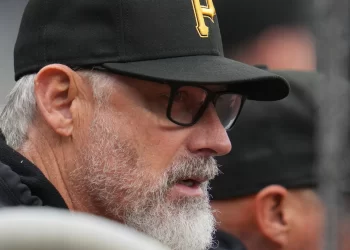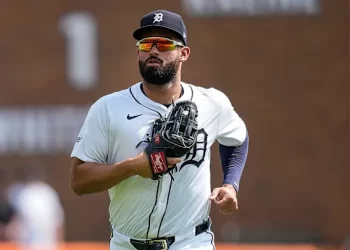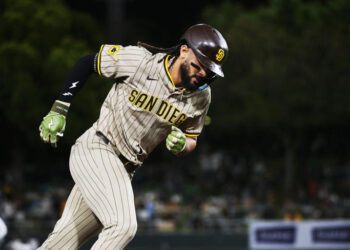By: Nicholas Mukhar
The current pace of a Major League Baseball game just isn’t as appealing to the new generation of fans as it was to hardcore “seamheads” in decades past.
It’s a hard pitch to take for baseball purists who have scoffed and eye-rolled at the League’s attempts to accelerate pace-of-play over the years, from capping the number of visits a pitching coach can make to the mound, to implementing instant replay which rendered the theatrical but long-winded manager v. umpire arguments obsolete, to starting with a runner on base in extra innings and narrowing down the possibility of a seven-hour, 18-inning marathon.
The numbers don’t lie
From 2017-2019, MLB game attendance decreased by 5.7%. From 2019-2021, television viewership fell by 12%. Since rolling out new pace-of-game rules, average game attendance has bounced back a bit and is only down approximately 1% overall since 2017.
According to Forbes, the average age of baseball fans is still high at 57 years old. That’s considerably older than the NFL, NBA and NHL. Translation? There’s a lot of modernization work to be done if MLB wants to keep pace with the other big 3 U.S. sports leagues and generate interest among a younger fan base.
As a result, baseball is now introducing perhaps the most drastic change since raising the pitcher’s mound in 1903: The pitch clock. That’s right, baseball will no longer be the only professional sport in North America not regulated by a game clock.
It’s a change that will likely frustrate the purists once again while appealing to a new demographic.
Here are three proposed amendments to the pitch clock rule that may help MLB satify both traditional and modern fan bases, ultimately building a smoother bridge into a new era of baseball without leaving a generation behind.
1. No K’s on the Clock
The pitch clock is probably more aptly named the pitcher-batter clock. The new rule gives pitchers 15 seconds to rest and reset before the next pitch (20 seconds if there’s a runner on base), and 30 seconds for the hitting team to switch batters. If the pitcher takes too long, a ball is added to the hitter’s count. If the hitter lingers, it’s a strike.
The problem is, with two strikes, a batter can strike out on a clock violation. During Spring training we’ve seen several players strike out due to a clock violation because they took too long to get back into the batter’s box. Just as a batter can’t strike out when hitting a foul ball with two strikes, an at-bat with two strikes should continue if the hitter is a second or two late getting ready for the next pitch.
2. Bases Empty in Extra’s
The pitch clock shaving off time between at-bats and between pitches allows the league to get back to basics in extra innings. Currently, each extra inning starts with a runner on second base. That means 3 attempts to get a base hit and score the game-leading or game-winning run.
Let’s eliminate arena/arcade baseball in extra innings. Play it out with no runners on base to start the inning, and make teams earn a W just like they would in the first nine innings of play.
3. Press Pause in the Postseason
The pitch clock rule will ruin playoff baseball. There’s no added runner rule in extra innings during the postseason, and there shouldn’t be a pitch clock either. And it’s for the same reason that extra innings revert back to regular rules come playoff time: Accelerated games will kill the drama and suspense of the tournament.
Do we really want to do away with the epic pitcher-batter poker game, the catcher rolling through signs in order to keep hitters off balance and guessing what’s being thrown next? Do we want batters to miss a key sign in the late innings of a crucial playoff series because they’re hurrying into the batter’s box?
In the worst case scenario, a World Series could end on a walk because the pitch didn’t come quick enough, or maybe because a batter was a half second late into the box and struck out on the pitch clock rule. MLB playoff and World Series games are highly rated televised events without the pitch clock. Don’t change what isn’t broken.
Will new rules save baseball?
Maybe a better question is, “Does baseball actually need saving?”
Stadiums are still sold out for opening days, playoffs, and World Series matches. The Major League Baseball All-Star Game is still the most most watched all-star game of any of the four major American sports leagues.
No doubt there’s room for improvement for the great game that for years has been struggling to remain culturally relevant. This Spring training, MLB seems to be getting the kind of improvement it’s been looking for. With the pitch clock in place, games are roughly 20 minutes shorter than they were a year ago. Even those of us who romanticize the idea of baseball being played in its truest form can’t argue with those early results.
With the NFL and NBA make strong pushes to take their leagues global and make whatever rule amendments necessary to bring in new fans, baseball’s attempt to keep pace is a good sign for the future of the sport. And after a wildly successful World Baseball Classic, the league deserves the benefit of the doubt in determining the direction of America’s pastime.


 NFL
NFL









Comments 1